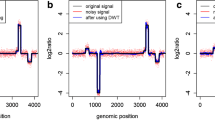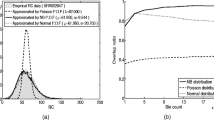Abstract
Copy number variation (CNV) plays important role in drug resistance in bacterial genomes. It is one of the prevalent forms of structural variations which leads to duplications or deletions of regions with varying size across the genome. So far, most studies were concerned with CNV in eukaryotic, mainly human, genomes. The traditional laboratory methods as microarray genome hybridization or genotyping methods are losing its effectiveness with the omnipotent increase of fully sequenced genomes. Methods for CNV detection are predominantly targeted at eukaryotic sequencing data and only a few of tools is available for CNV detection in prokaryotic genomes. In this paper, we propose the CNV detection algorithm derived from state-of-the-art methods for peaks detection in the signal processing domain. The modified method of GC normalization with higher resolution is also presented for the needs of the CNV detection. The performance of the algorithms are discussed and analyzed.
Access this chapter
Tax calculation will be finalised at checkout
Purchases are for personal use only
Similar content being viewed by others
References
Alkan, C., Coe, B.P., Eichler, E.E.: Genome structural variation discovery and genotyping. Nat. Rev. Genet. 12(5), 363–376 (2011)
Benjamini, Y., Speed, T.P.: Summarizing and correcting the GC content bias in high-throughput sequencing. Nucleic Acids Res. 40(10), 1–14 (2012)
Brynildsrud, O., Snipen, L.G., Bohlin, J.: CNOGpro: detection and quantification of CNVs in prokaryotic whole-genome sequencing data. Bioinformatics 31(11), 1708–1715 (2015)
Dohm, J.C., Lottaz, C., Borodina, T., Himmelbauer, H.: Substantial biases in ultra-short read data sets from high-throughput DNA sequencing. Nucleic Acids Res. 36(16), e105 (2008)
Duan, J., Zhang, J.-G., Deng, H.-W., Wang, Y.-P.: Comparative studies of copy number variation detection methods for next-generation sequencing technologies. PLoS One 8(3), e59128 (2013)
Holt, K.E., et al.: Genomic analysis of diversity, population structure, virulence, and antimicrobial resistance in Klebsiella pneumoniae an urgent threat to public health. Proc. Natl. Acad. Sci. 112(27), E3574–E3581 (2015)
Huang, W., Li, L., Myers, J.R., Marth, G.T.: ART: a next-generation sequencing read simulator. Bioinformatics 28(4), 593–594 (2012)
Li, H., Durbin, R.: Fast and accurate long-read alignment with Burrows-Wheeler transform. Bioinformatics 26(5), 589–595 (2010)
Li, H., et al.: The Sequence Alignment/Map format and SAMtools. Bioinformatics 25(16), 2078–2079 (2009)
Medvedev, P., Stanciu, M., Brudno, M.: Computational methods for discovering structural variation with next-generation sequencing. Nat. Methods 6(11S), S13 (2009)
Periwal, V., Scaria, V.: Insights into structural variations and genome rearrangements in prokaryotic genomes. Bioinformatics 31(1), 1–9 (2015)
Rocha, E.P.: The organization of the bacterial genome. Annu. Rev. Genet. 42(1), 211–233 (2008)
Treangen, T.J., Salzberg, S.L.: Repetitive DNA and next-generation sequencing: computational challenges and solutions. Nat. Rev. Genet. 13(1), 36–46 (2012)
Wyres, K.L., Holt, K.E.: Klebsiella pneumoniae as a key trafficker of drug resistance genes from environmental to clinically important bacteria. Curr. Opin. Microbiol. 45, 131–139 (2018)
Zhao, M., Wang, Q., Wang, Q., Jia, P., Zhao, Z.: Computational tools for copy number variation (CNV) detection using next-generation sequencing data: features and perspectives. BMC Bioinform. 14(Suppl. 1(Suppl. 11)), S1 (2013)
Acknowledgments
This work was supported by grant project GACR 17-01821S.
Author information
Authors and Affiliations
Corresponding author
Editor information
Editors and Affiliations
Rights and permissions
Copyright information
© 2019 Springer Nature Switzerland AG
About this paper
Cite this paper
Jugas, R., Vitek, M., Maderankova, D., Skutkova, H. (2019). Signal Processing Based CNV Detection in Bacterial Genomes. In: Rojas, I., Valenzuela, O., Rojas, F., Ortuño, F. (eds) Bioinformatics and Biomedical Engineering. IWBBIO 2019. Lecture Notes in Computer Science(), vol 11465. Springer, Cham. https://doi.org/10.1007/978-3-030-17938-0_9
Download citation
DOI: https://doi.org/10.1007/978-3-030-17938-0_9
Published:
Publisher Name: Springer, Cham
Print ISBN: 978-3-030-17937-3
Online ISBN: 978-3-030-17938-0
eBook Packages: Computer ScienceComputer Science (R0)




